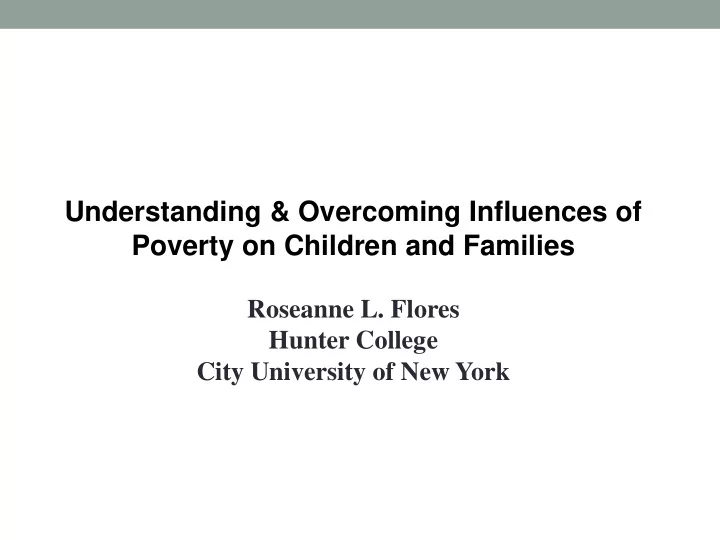

Understanding & Overcoming Influences of Poverty on Children and Families Roseanne L. Flores Hunter College City University of New York
Michael and Gabriel’s Story
Presentation Overview Family and Child Poverty in the United States Individual and Structural Determinants of Poverty The Cycle of Poverty in Families Indicators of Child Well-Being The Consequences of Poverty on Child and Family Well-Being Fostering Resilience in Children and Families
2014 Federal Poverty Guidelines 1 Federally facilitated marketplaces will use the 2014 guidelines to determine eligibility for Medicaid and CHIP (this is effective February 10, 2014). Household Size 100% 133% 150% 200% 250% 300% 400% 1 $11,670 $15,521 $17,505 $23,340 $29,175 $35,010 $46,680 2 15,730 20,921 23,595 31,460 39,325 47,190 62,920 3 19,790 26,321 29,685 39,580 49,475 59,370 79,160 4 23,850 31,721 35,775 47,700 59,625 71,550 95,400 5 27,910 37,120 41,865 55,820 69,775 83,730 111,640 6 31,970 42,520 47,955 63,940 79,925 95,910 127,880 7 36,030 47,920 54,045 72,060 90,075 108,090 144,120 8 40,090 53,320 60,135 80,180 100,225 120,270 160,360 Extracted verbatim from familiesusa.org
Facts about Family Poverty in United States 2 Families living between 100 and 200 percent of the federal poverty level are at risk for missing rent and bill payments, not having access to adequate childcare, running out of food, and having poor quality health care. Single parent families have a greater risk for experiencing economic hardship than two parent families. Lower levels of parental education contributes to lower incomes and poverty
Families with Related Children That Are Below Poverty by Family Type 3
Facts about Child Poverty 4 Children growing up in poverty are placed at risk for experiencing poor development outcomes. Health Care and Nutrition Many children suffer from food insecurity Greater risk for experiencing poor health outcomes Education Children have poorer educational, cognitive and social emotional outcomes. Limited access to high quality education Exploitation Greater risk for experiencing abuse and neglect Greater risk for being exposed to and victims of violence
Children in Poverty (100 percent poverty) 3
Children Living in Areas of Concentrated Poverty 3
Individual and Structural Determinants of Poverty 5,7 Individual Determinants Structural Determinants Limited Education Limited Access to Quality Health Care Fewer Financial Resources Poorer Neighborhoods Fewer Social Resources Limited Access to High Quality Education Poorer Health Limited Access to High Paying Jobs Greater Exposure to Stress Insufficient Housing Limited Income Higher Exposure to Community Violence
The Cycle of Poverty in Families 2 Poverty Child Family Circumstances Well-Being
Indicators of Child Well-Being 5 Six dimensions affecting child well-being are: Material well-being Housing and environment Education Health Risk behaviors Quality of school life
Consequences of Poverty on Child and Family Well-Being 4 Poverty can be viewed as a toxic stressor. Exposure to ongoing stress - that can result from exposure to violence, limited access to economic resources, and instability within families and communities–all of which can effect child well-being. Families living in poverty tend to live in overcrowded neighborhoods, environments exposed to chemical toxins, communities with limited cultural, social and financial capital, and have a greater exposure to violence.
Consequences of Poverty on Child and Family Well-Being 6 An accumulation of these factors can lead to poorer health outcomes for children and families.
Working with Families and Children to Support Resilience 6 “Resilience” involves the ability to do well in the face of adversity and trauma. Resilience is not innate and can be fostered in children and families.
Helping to Foster Resilience 6 Individual Level It should be fostered at the individual level – working with children to develop problem solving skills, social competence, and confidence. Family Level It should be fostered at the family level - working with families to develop warm and engaging relationships and social supports Community Level It should be fostered at the community level - helping children and families develop supportive relationships with members of the larger community.
Supporting Family and Child Well-Being Strong Communities Strong Thriving Families Children
References 1. Federal Poverty Guidelines for 2014. Retrieved from http://familiesusa.org/product/federal-poverty-guidelines 2. Crane, D. R. R., & Heaton, T. B. (Eds.). (2007). Handbook of families and poverty. Sage Publications. 3. The Annie E. Casey Foundation, KIDS COUNT Data Center, datacenter.kidscount.org 4. Facts about children and poverty. Retrieved from http://www.care.org/work/poverty/child-poverty/facts. 5. Murphy, D., Stratford, B., goose, R., Bringewatt, E., Cooper, P., Carney, R., & Rojas, A. (July 2014). Are the children well? A model of recommendations for promoting the mental wellness of that Nation’s young people. (Policy Brief). Child Trends: Washington, DC. 6. Fitzpatrick, K. M. (Ed.). (2013). Poverty and Health: A Crisis Among America's Most Vulnerable [2 volumes]: A Crisis among America's Most Vulnerable. ABC-CLIO. 7. Pollard, E. L., & Lee, P. D. (2003). Child well-being: a systematic review of the literature. Social Indicators Research, 61(1), 59-78
Recommend
More recommend